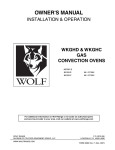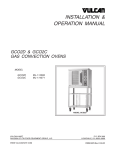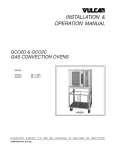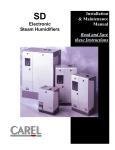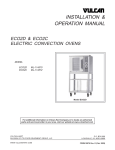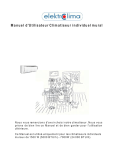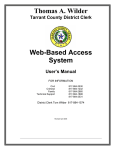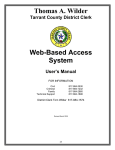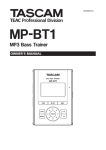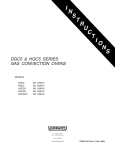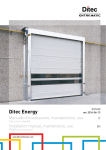Download Hitachi 61UDX10B Projection Television User Manual
Transcript
HGC20 & HGC20D GAS CONVECTION OVENS MODELS HGC20 HGC20D ML-114573 ML-114575 701 S. RIDGE AVENUE TROY, OHIO 45374-0001 937 332-3000 www.hobartcorp.com FORM 33580 Rev. E (Mar. 2005) IMPORTANT FOR YOUR SAFETY THIS MANUAL HAS BEEN PREPARED FOR PERSONNEL QUALIFIED TO INSTALL GAS EQUIPMENT, WHO SHOULD PERFORM THE INITIAL FIELD START-UP AND ADJUSTMENTS OF THE EQUIPMENT COVERED BY THIS MANUAL. POST IN A PROMINENT LOCATION THE INSTRUCTIONS TO BE FOLLOWED IN THE EVENT THE SMELL OF GAS IS DETECTED. THIS INFORMATION CAN BE OBTAINED FROM THE LOCAL GAS SUPPLIER. IMPORTANT IN THE EVENT A GAS ODOR IS DETECTED, SHUT DOWN UNITS AT MAIN SHUTOFF VALVE AND CONTACT THE LOCAL GAS COMPANY OR GAS SUPPLIER FOR SERVICE. FOR YOUR SAFETY DO NOT STORE OR USE GASOLINE OR OTHER FLAMMABLE VAPORS OR LIQUIDS IN THE VICINITY OF THIS OR ANY OTHER APPLIANCE. WARNING: IMPROPER INSTALLATION, ADJUSTMENT, ALTERATION, SERVICE OR MAINTENANCE CAN CAUSE PROPERTY DAMAGE, INJURY OR DEATH. READ THE INSTALLATION, OPERATING AND MAINTENANCE INSTRUCTIONS THOROUGHLY BEFORE INSTALLING OR SERVICING THIS EQUIPMENT. IN THE EVENT OF A POWER FAILURE, DO NOT ATTEMPT TO OPERATE THIS DEVICE. © HOBART CORPORATION, 1996, 2005 –2– Installation, Operation, and Care of HGC20 AND HGC20D GAS CONVECTION OVENS SAVE THESE INSTRUCTIONS FOR FUTURE USE GENERAL The HGC20 Gas Convection Oven is a single cavity oven and features a solid state thermostat, 1-hour dial timer, and five racks as standard equipment. Additional oven racks are optional. Each oven is equipped with a 25,000 BTU/hr burner and a 1/2 HP (0.37 kw) electric motor. The oven comes standard with porcelain interior; stainless steel exterior. Model HGC20D is similiar to model HGC20, except the HGC20D has either an electronic control or programmable control package in place of the solid state controller. Two single ovens can be ordered with a stacking kit for mounting one oven on top of the other. A single oven may be installed on an open stand with lower storage rack (optional). COOK & GENTLE RACK # HOLD BAKE COOK TIMES MODEL THERMOSTAT TIMER HGC20 Solid State 1-Hour Dial HGC20D before Octover 1999 Electronic Electronic X Programmable Programmable X HGC20D after October 1999 X X INSTALLATION UNPACKING Immediately after unpacking the oven, check for possible shipping damage. If this oven is found to be damaged, save the packaging material and contact the carrier within 15 days of delivery. Prior to installation, verify that the electrical supply and type of gas supply (natural or propane) agree with the specifications on the oven data plate, located on the inside of the top front cover. Do not use the door or its handle to lift the oven. LOCATION The equipment area must be kept free and clear of combustibles. Maintain clearances from combustible or noncombustible construction for at least 3" (7.6 cm) from the side and 3" (7.6 cm) from the back of the oven. The installation location must allow adequate clearances for servicing and proper operation. The oven must be installed so that the flow of combustion and ventilation air will not be obstructed. Adequate clearance for air openings into the combustion chamber must be provided. Make sure there is an adequate supply of air in the room to allow for that required for combustion of gas at the oven burners. –3– INSTALLATION CODES AND STANDARDS Hobart ovens must be installed in accordance with: In the United States of America: 1. State and local codes. 2. National Fuel Gas Code, ANSI-Z223.1 (latest edition). Copies may be obtained from The American Gas Association, Inc., 1515 Wilson Blvd., Arlington, VA 22209. 3. National Electrical Code, ANSI/NFPA-70 (latest edition). Copies may be obtained from The National Fire Protection Association, Batterymarch Park, Quincy, MA 02269. In Canada: 1. Local codes. 2. CSA B149.1 Natural Gas and Propane Installation Code. 3. CSA C22.2 Canadian Electrical Code. The above are available from the Canadian Standard Association, 5060 Spectrum Way, Suite 100, Mississauga, Ontario, Canada L4W 5N6. Ovens Mounted on Casters Ovens mounted on casters must use a flexible connector (not supplied by Hobart) that complies with the Standard for Connectors for Movable Gas Appliances, ANSI Z21.69 • CSA 6.16 and a quickdisconnect device that complies with the Standard for QuickDisconnect Devices for Use With Gas Fuel, ANSI-Z21.41 • CSA 6.9. In addition, adequate means must be provided to limit movement of the appliance without depending on the connector and the quickdisconnect device or its associated piping to limit appliance movement. Attach the restraining device at the rear of the oven as shown in Fig. 1. CONNECT GAS LINE STRAIN RELIEF HERE PL-53563 Fig. 1 If disconnection of the restraint is necessary, turn off the gas supply before disconnection. Reconnect this restraint prior to turning the gas supply on and returning the oven to its installation position. Separate instructions for installing casters to the oven are included with the casters. Note: If the oven is installed on casters and is moved for any reason, it is recommended that the oven be releveled front to back and side to side for even baking. Assembling the Legs to the Single Oven The 4" (10 cm) or 6" (15 cm) legs are packed inside the oven during shipment and must be installed on the bottom of the oven. Place the oven on its left side, being careful to avoid scratching the finish. The gas pipe connection protrudes beyond the back; provide for this when oven is tipped back by resting it on suitable spacers (2 x 4's etc.). Thread each of the four leg assemblies into the holes provided on the bottom corners of the oven. Carefully raise the oven to its normal upright position. –4– Assembling the Chimney to the Single Oven CHIMNEY Remove the chimney from inside the oven cavity and use the screws provided to fasten the chimney to the top rear of the oven (Fig. 2). The flanges on the chimney are to be positioned over the top cover. ASSEMBLING THE OVEN TO THE STAND Position the oven on its back, taking care not to scratch or damage it. The gas pipe connection protrudes beyond the back; provide for this when the oven is tipped back by resting it on suitable spacers (2 x 4's). Install the two locating studs (included in the stand carton) into the screw plates on the underside of the oven (Fig. 3). Attach each of the four leg assemblies to the bottom of the stand with the 12 bolts and lockwashers (3 per leg). If casters are used instead of legs, put fixed casters in rear and swivel casters in front using 12 bolts and lockwashers (3 per caster). Mount the oven on top of the stand. PL-52240 Fig. 2 FRONT OF TOP OVEN LOCATING STUDS ASSEMBLING STACKED OVENS Determine which oven will be on the bottom and place it on its left side, being careful to avoid scratching the finish. Install the four 163/4" (42.5 cm) legs, using the 24 bolts and lockwashers provided (6 per leg). Remove the two 7/16" (1.1 cm) knockouts on each side of the top cover and place oven in upright position at installation location. Turn the adjustable feet in or out to level the oven front-to-back and side-to-side (refer to LEVELING, page 6). Remove right-hand side panels from both ovens. Remove welded plate from bottom of upper oven (Fig.3). Install the two locating studs (included in leg stack set) into screw plates on underside of upper oven (Fig. 3). Place upper oven on top of lower oven using the locating studs. BOTTOM KNOCK OUT WELDED PLATE FOR FLUE EXTENSION INSTALLATION REAR OF TOP OVEN PL-52992 Fig. 3 Remove flue extension from upper oven. Install long flue extension into existing right-angled flue extension in lower oven. Attach long flue extension to wall of upper oven using screws provided. Secure chimney to roof of upper oven (Fig. 4). Install right side panels on both ovens. Connect the piping between the top oven and bottom oven. Pipe compound must be resistant to the action of propane gases. The manual gas valve at the bottom of the control panel should remain off until all electrical connections are made and the ovens are checked or used. CHIMNEY LONG FLUE EXTENSION RIGHT ANGLED FLUE EXTENSION PL-52221 Fig. 4 –5– LEVELING Once the oven is in its permanent position, place a carpenter's level on the oven rack. If the oven is installed on legs, turn the adjustable feet in or out to level oven front-to-back and side-to-side. If the oven is installed on casters, loosen set screws and turn casters in or out to level oven front-to-back and side-to-side. Retighten set screws after leveling. ELECTRICAL CONNECTIONS WARNING: ELECTRICAL AND GROUNDING CONNECTIONS MUST COMPLY WITH THE APPLICABLE PORTIONS OF THE NATIONAL ELECTRICAL CODE AND/OR OTHER LOCAL ELECTRICAL CODES. WARNING: DISCONNECT THE ELECTRICAL POWER TO THE MACHINE AND FOLLOW LOCKOUT / TAGOUT PROCEDURES. WARNING: APPLIANCES EQUIPPED WITH A FLEXIBLE ELECTRIC SUPPLY CORD ARE PROVIDED WITH A THREE-PRONG GROUNDING PLUG. IT IS IMPERATIVE THAT THIS PLUG BE CONNECTED INTO A PROPERLY GROUNDED THREE-PRONG RECEPTACLE. IF THE RECEPTACLE IS NOT THE PROPER GROUNDING TYPE, CONTACT AN ELECTRICIAN. DO NOT REMOVE THE GROUNDING PRONG FROM THIS PLUG. The 120 volt models are equipped with a cord and plug. Refer to electrical wiring diagram located inside the right side panel; remove control panel for access. Do not turn the power supply on until after the gas connections have been made and checked for leaks. ELECTRICAL DATA Minimum Circuit Ampacity Maximum Protective Device MODEL HGC20 HGC20D Volts Hertz Phase AMPS 120 60 1 15 200 - 240 50 1 15 200 - 240 60 1 15 120 60 1 15 200 - 240 50 / 60 1 15 Complied in accordance with the National Electrical Code, NFPA-70 (latest edition). –6– GAS CONNECTION GAS DATA INPUT / BTU/HR MANIFOLD PRESSURE MODEL Natural Propane Natural Propane HGC20, HGC20D 25,000 25,000 3.5" w.c. (0.8 kPa) 10" w.c. (2.5 kPa) For all gas supply connections, pipe joint compound must be resistant to the action of propane gases. The oven is provided with a regulator integral to the gas solenoid valve, and requires no regulator external to the device. A gas shutoff valve is supplied with each oven and is located at the bottom of the control panel. No tools are required to access this valve. Connect the oven(s) to the gas line after leveling. The gas supply line must be at least the equivalent of 3/4" (1.9 cm) iron pipe. Make sure the pipes are clean and free of obstructions, dirt and piping compound. WARNING: PRIOR TO LIGHTING, CHECK ALL JOINTS IN THE GAS SUPPLY LINE FOR LEAKS. USE SOAP AND WATER SOLUTION. DO NOT USE AN OPEN FLAME. TESTING THE GAS SUPPLY SYSTEM The oven and its individual shutoff valve must be disconnected from the gas supply piping system during any pressure testing of that system at test pressures greater than 1/2 psig (3.45 kPa). The oven must be isolated from the gas supply piping system by closing the manual shutoff valve during pressure testing of the gas supply system at test pressures equal to or less than 1/2 psig (3.45 kPa). GAS PRESSURES AND ORIFICES Natural Gas The burner orifices are sized to deliver the nameplate input rating (25,000 BTU/hr) at a gas manifold pressure of 3.5" w.c. (water column)(0.8 kPa). The gas pressure regulator is integral to the gas solenoid valve, and is factory set to supply 3.5" w.c. (0.8 kPa) as required for natural gas. Propane Gas The burner orifices are sized to deliver the nameplate input rating (25,000 BTU/hr) at a gas manifold pressure of 10.0" w.c. (water column)(2.5 kPa). The gas pressure regulator is integral to the gas solenoid valve, and is factory set to supply 10.0" w.c. (2.5 kPa) as required for propane gas. BURNER AIR SHUTTER ADJUSTMENTS The burner has fixed, factory adjusted air openings and requires no field adjustment. –7– FLUE CONNECTION Ventilation requirements will vary with each installation and must comply with Vapor Removal from Cooking Equipment, NFPA Standard #96 (latest edition) and with local codes. Considerations to be kept in mind include: • Flue connections should never be made directly to the oven. • The oven should be located under a hood which has an adequate connection to an exhaust duct and extends 6" (15 cm) beyond the oven sides. • Clearance above the oven flue should be adequate for the flue products to escape so that there is no interference with the heat circulation in the ovens. OPERATION WARNING: THE OVEN AND ITS PARTS ARE HOT. USE CARE WHEN OPERATING, CLEANING, OR PERFORMING ANY MAINTENANCE. CONTROLS — MODEL HGC20 (Fig. 5) ON / OFF / COOL DOWN Switch • Turns oven control circuits ON or OFF; or COOL DOWN allows the fan motor to run with the doors ajar to speed oven cooling. ON/OFF/COOL DOWN SWITCH POW ER ON OFF COO L DO WN ;; THERMOSTAT • Controls oven temperature during cooking operation. ON LIGHT ON HEAT HEAT LIGHT IGNI TION COOK TEMP ERAT URE NO IGNITION LIGHT TEMP F 50 0 47 5 15 0 45 0 22 5 42 5 40 0 25 0 35 0 30 0 30 0 COOK THERMOSTAT ON LIGHT (Amber) • Is lit when the ON / OFF / COOL DOWN switch is positioned at ON or COOL DOWN. TIME ;;; ;;; ;;; ;;; 0 60 F OF 5 55 10 50 15 45 40 TIMER HEAT LIGHT (White) • Comes on and goes off when the burner cycles on and off. 20 35 30 25 TO LIG PLAC HT OVEN E SWIT ON/OFF CH IN /C ADFG "ON" OOL DO WN TO SHAPDF;LJ POSITION K; . PLAC UT-OFF LJ;LKJ OV E SWIT ON/OFF EN CH IN /C "OFF OOL DO W " PO SITIONN . NO IGNITION LIGHT (Red) • Comes on if burner fails to ignite after the third try. When lighting the oven, the NO IGNITION LIGHT cycles ON during the 5 second purge and OFF during the 7 second ignition trial. ON OFF TIMER • Use to set cooking cycle time. The timer range is from 0 to 60 minutes. Alarm sounds continuously when elapsed time counts down to 0; oven does not turn off. Turn timer to OFF position to stop alarm. When oven is not in use, keep timer at OFF position. GAS VALVE GAS VALV E PLAC TO LIGHT E SWIT ON/OFF OVEN /COO CH IN L DO "ON" ADFG APDF POSITI WN ;LJK; ON LJ;LK . J PL-52227 GAS VALVE • When ON, allows gas to flow to the ignition system. Fig. 5 –8– LIGHTING THE HGC20 OVEN Open the manual valve. Turn the ON / OFF / COOL DOWN switch ON and turn the thermostat to its maximum setting. Both the ON and HEAT lights should be lit. If the HEAT light is not on, make sure the door is closed. After 5 seconds, the spark ignition system will initiate and the solenoid valve will open, allowing gas flow to the burner for a period of 7 seconds. This 5 second purge and 7 second ignition trial will repeat itself up to two more times if the burner does not light within the first 7 second ignition trial. During the 5 second prepurge, the red NO IGNITION light will be lit. When the burner gas ignites, a slight "roar" will be audible. This "roar" is a normal condition of the power burner, and will become almost undetectable in the normal operating mode after warm-up. The NO IGNITION light will go off when ignition occurs. If the burner fails to light after three trials, the red NO IGNITION light will be illuminated and remain on. Turn the ON / OFF /COOL DOWN switch to OFF for five minutes before repeating the operating sequence listed above. If burners do not light after five trials, turn off the manual valve and call your local Hobart service office. BEFORE FIRST USE Before the oven is used for the first time, it must be "burned in" to release any odors that might result from heating the new surfaces in the chamber. Using a clean damp cloth, wipe the inside of the oven, including the racks. Close the oven door, turn the ON / OFF / COOL DOWN switch ON, turn the thermostat to 300°F (149°C) and allow the oven to cycle for 6 to 8 hours before turning the switch OFF. USING THE HGC20 OVEN Preheating 1. Turn ON / OFF / COOL DOWN switch ON. The amber ON light will come on, indicating that power to the oven is on. 2. Set the THERMOSTAT as desired. Refer to SUGGESTED COOKING GUIDELINES for temperatures and times for various products. 3. Prepare product and place in suitable pans. When the white HEAT light goes off, the oven has reached desired preheat temperature. Cooking 1. Open the door and load the product into the oven. Place pans in the center of racks. Close the door. 2. Set the TIMER. After the preset time lapses, turn timer OFF to stop the buzzer. 3. When product is done, open the door and carefully remove the cooked product from the oven. Wipe up any spills. End of Day 1. Turn the THERMOSTAT OFF. 2. Turn ON / OFF / COOL DOWN switch to COOL DOWN. 3. Leave door ajar while the fan is on to cool the oven. 4. When oven has cooled sufficiently, turn the ON / OFF / COOL DOWN switch OFF and clean the oven. –9– CONTROLS — MODEL HGC20D Built before October 1999 (Fig. 6) HEAT LIGHT TEMPERATURE KNOB COOK BUTTON THERMOSTAT TEMPE RATURE READY LIGHT HEAT READ Y HOLD BUTTON COOK HOLD THERMOMETER BUTTON TIMER TIMER KNOB TIME COOK BUTTON COOK START/STOP BUTTON PULSE BUTTON STAR T STOP PULS E ;;; ;; ; ;;; ;; ;;; ; ;;; POWER ON ON / OFF / COOL DOWN SWITCH OFF COOL DOWN LIG da;la ;la sjfd; ads;f HTING a jj;flPU IN SH MA STRUCT "ON" IONS STER PO FAILS STION. SWITC H TO TO LIG IF OV HT. PU EN SH ON OFF GAS VALVE GAS VALV E sdifja ds ;lld asdh;fjalkdfja;sjfjlfdal; flkajs eflas df;lfsdj; shdjf dkjhflasa;l lkajh klasj PL-52226 Fig. 6 THERMOSTAT CONTROL Temperature Display (When not timing product). Displays set cook temperature while the light in the Cook Button is lit. It will be overridden to display the actual cavity temperature for 8 seconds when the Thermometer Button is pushed. 1. The light in the Thermometer Button will be lit while the actual temperature is being displayed. 2. The light in the Thermometer Button will extinguish when the display returns to set temperature display. Temperature Display (When product is being timed). Displays set hold temperature while the light in the Hold button is lit. Displays the cook temperature when the Cook button is lit. Will be overridden to display actual cavity temperature for 8 seconds when the Thermometer Button is pushed. 1. The light in the Thermometer Button will be lit while actual temperature is being displayed. 2. The light in the Thermometer Button will extinguish when the display returns to set temperature display. Temperature Knob (When not timing product). 1. Sets the cook temperature when the Cook Button light is lit. The Cook Button light can be turned on by pressing the Cook Button. 2. Sets the hold temperature when the Hold Button light is lit. The Hold Button light can be turned on by pressing the Hold Button. Temperature Knob (When product is being timed). 1. Sets the cook temperature when the Cook Button light is lit. The Cook Button light cannot be changed by pressing the Cook Button. 2. Sets the hold temperature when the Hold Button light is lit. The Hold Button light cannot be changed by pressing the Hold Button. – 10 – Cook Button Light (If On and not timing product). Indicates the cook mode is selected. This means: • The displayed temperature settings will be for the cook temperature except for the time that the light in the Thermometer Button is lit. • Rotating the Thermostat Knob will change the cook set temperature. • Cook time can be adjusted using the Timer Knob. • The time displayed is the initial set cook time. • It is possible to select the Hold mode using the Hold Button. Cook Button Light (If On and product is being timed). Indicates the cook mode is selected. This means: • The displayed temperature settings will be for the cook temperature except for the time that the light in the Thermometer Button is lit. • Rotating the Temperature Knob will change the cook set temperature. • It is not possible to select the Hold mode using the Hold Button. • The time displayed is the time counted down from the initial cook time set. Cook Button 1. Lights the Cook Button light. See Cook Button Light above. 2. Selects the Cook mode. 3. Has no effect if timing in the Hold mode. Thermometer Button — When pressed, causes actual cavity temperature to display for about 8 seconds, then display returns to set temperature. Heat Light — When lit, indicates that power is being supplied to the burner. Ready Light — Will be lit any time the actual temperature is within 5 F° (3 C°) of the set temperature for the current mode. TIMER CONTROL Time Display (While not timing product). — Displays the set cook time if the light in the Cook Button is lit. Time Display (While product is being timed). 1. Displays the counted down cook time if the Cook Button light is lit and in the Cook mode. 2. Displays the counted up hold time if the Hold Button light is lit and in the Hold mode. Count-up of hold time does not begin until cavity temperature reaches the hold temperature. Time Display Colon 1. Is flashing if product is timing. 2. Is not flashing product is not being timed. Time Button — Press to set cooking cycle time. Time Button Light — Is lit when the Time Button is pressed. Timer Knob — Sets the cook time when not already timing and the Cook Time indicator is lit. – 11 – Pulse Button Selects the pulse time setting. A cook time must be set first. The pulse time can then be set equal to or less than the cook time. The pulse time will be the portion of cook time to operate in the pulse mode. Pulse mode will start first. When pulse time elapses, the remainder of the cook time will be in the nonpulse mode. Use when cooking delicate product, such as strudel, muffins, cupcakes, meringue pies, etc., to keep product from forming waves on the top. Use the Pulse Button to switch between the selection of pulse mode and non-pulse mode. A pulse time of zero selects non-pulse mode. The light in the Pulse Button will be lit when in the pulse mode. Pulse Mode — The fan cycles ON 45 seconds and OFF 45 seconds for the duration of the Pulse cycle. • The fan stays on while the heat cycles in hold mode. • The fan stays on while heat cycles at 100% power when not timing. • Pulse Mode can be switched on or off at any time. Stop / Start Button 1. Starts timing a product in the mode selected if a cook time has been set. 2. Stops timing of a product if a timing sequence has already started. Hold Button — Selects Hold mode. 1. Allows selection of hold temperature. 2. Temperature indication of ---°F (---°C) indicates no hold mode. Hold Button Light — Is lit when in the Hold mode. 1. When not timing, allows setting / enabling a hold mode setting of ---°F (---°C), meaning no hold will take effect. 2. Any other temperature means that when the actual cook time has ended, the oven will enter the Hold mode and use the hold temperature. On / Off / Cool Down Switch 1. ON turns oven control circuits on. 2. OFF turns oven control circuits off. 3. COOL DOWN allows the fan motor to run with the doors ajar to speed oven cooling. Gas Valve — When ON, allows gas to flow to the ignition system. LIGHTING THE HGC20D OVEN 1. Turn manual gas valve ON. 2. Push the ON / OFF / COOL DOWN switch ON and set the THERMOSTAT to its maximum setting. The HEAT light should come on. If HEAT light is not on, make sure the door is closed. 3. If the oven fails to light, push the ON / OFF / COOL DOWN switch OFF. Wait 5 minutes before trying to relight the oven. – 12 – BEFORE FIRST USE Before using the oven for the first time, it must be "burned in" to release any odors that might result from heating the new surfaces in the chamber. 1. Using a clean damp cloth, wipe the inside of the oven, including the racks. 2. Close the oven door, push the ON / OFF / COOL DOWN switch ON, turn the thermostat to 300°F (149°C) and allow the oven to cycle for 6 to 8 hours before turning the ON / OFF / COOL DOWN switch OFF. USING THE HGC20D OVEN Preheating 1. Push ON / OFF / COOL DOWN switch ON. The HEAT light will come on, indicating that power to the oven is on. 2. Set the THERMOSTAT as desired. Refer to SUGGESTED COOKING GUIDELINES for temperatures and times. 3. Prepare product and place in suitable pans. When READY light comes on, oven has reached desired preheat temperature. Cooking 1. Open the door and load the product into the oven. Place pans in the center of the racks. Close the door. 2. Set COOK temperature and time. Set HOLD temperature and PULSE time, if desired. PULSE time may not be more than COOK time. PULSE will cycle the fan during the set time at the beginning of the cook cycle. 3. Press the START / STOP button to start the cooking cycle. 4. At the end of the cooking cycle, the buzzer will sound continuously if the HOLD mode is OFF. If the HOLD mode is ON, there will be a short beep at the beginning of Second Stage Cooking (oven temperature will begin to decline to the HOLD temperature), and a long beep (20 seconds) at the end of the cooking cycle. Refer to COOK AND HOLD OPERATION. 5. When product is done, open the door and carefully remove cooked product from the oven. Wipe up any spills. End of Day 1. Push ON / OFF / COOL DOWN switch to COOL DOWN. Leave door ajar while the fan is on to cool the oven. 2. When the oven has cooled sufficiently, push the ON / OFF / COOL DOWN switch OFF and clean the oven. ERROR MESSAGES — HGC20D OVEN E-01 High limit error. Contact your local Hobart service office. E-02 Low limit error. Contact your local Hobart service office. E-03 High ambient temperature, 215°F (102°C). Contact your local Hobart service office. E-04 Low ambient temperature, 32°F (0°C). Let control warm up after cold storage. E-05 Ignition failure. After trying ignition three times, contact your local Hobart service office. E-06 Thermocouple probe open. Contact your local Hobart service office. When calling for service, please advise what error code was displayed. – 13 – CONTROLS — MODEL HGC20D Built after October 1999 Always displays [HR:Min] when setting the Time. Displays [HR:Min] if the countdown Time is more than 1 Hour. Displays [Min: Sec] if the countdown Time is less than 1 Hour. Displays Temperature in °F. OVEN READY C&H MODE OVEN HEATING MENU SELECT SECONDARY 1 2 SET 1 3 5 3 2 4 6 Indicates the oven is in the Cook and Hold Mode. C&H MODE PRIMARY COOK & HOLD 4 START 5 STOP MENU Indicates the oven is preheated and ready for cooking. OVEN READY OVEN HEATING PRIMARY SECONDARY Primary indicates Menu Items 1, 3, or 5. Secondary indicates Menu Items 2, 4, or 6. Up arrow to increase; Down arrow to decrease — any programming function. RACK TEMPERATURE: Use with SET to set the oven Temperature. POWER NO IGNITION Indicates the oven is preheating. ON OFF SET: Use with Time or Temperature. SET COOL DOWN TIME: Use with SET to manually set the cooking Time. ON OFF COOK & HOLD Selects Cook and Hold mode. START Press once to start; press a second time to stop. STOP 1/2 3/4 5/6 Select Menu Cook Times. Press once for Primary (1, 3, or 5). Press a second time for Secondary (2,4,6). See next page. PL-53545 1 2 3 4 5 Rack Buttons select individual Menu / Rack # Cook Times — once programmed. – 14 – MANUALLY SETTING THE TEMPERATURE AND COOK TIME To Set the Temperature • Press the SET button. Press the TEMPERATURE button; StPt displays to indicate Setpoint. • Use the Up and Down Arrow keys to increase or decrease the displayed Temperature value. • Press the SET button again to save the Temperature setpoint in the computer. To Set the Cook Time • Press the SET button. Press the TIME button. Tine displays to indicate TIME. • Use the Up and Down Arrow keys to increase or decrease the displayed Cook Time (HR:min). • Press the SET button again to save the Time setting in the computer. To Start Cooking • Press the START / STOP button. • The manual Cook Time counts down to 00:00. Displays [HR:Min] above 1 hour; [min: sec] below. • The buzzer will sound. To silence the buzzer, press the START / STOP button again. * The control retains the manual settings for Temperature and Time. TO PROGRAM MENU ITEM and RACK # Cook Times Factory Preset and Programmable Cook Times are shown in the table, below: MENU SELECTION 1/2 1/2 3/4 3/4 5/6 5/6 Primary Secondary Primary Secondary Primary Secondary MENU ITEM 1 2 3 4 5 6 PROGRAMMABLE VALUES FACTORY PRESET MENU ITEM MENU ITEM RACK 1 RACK 2 RACK 3 RACK 4 RACK 5 COOK TIME COOK TIME COOK TIME COOK TIME COOK TIME COOK TIME COOK TIME 10 min. 15 min. 20 min. 25 min. 30 min. 35 min. The Primary indicator light with Menu 1 / 2 selects Menu Item 1 (Factory Preset Cook Time = 10 minutes). The Secondary indicator light with Menu 1 / 2 selects Menu Item 2 (Factory Preset Cook Time = 15 minutes). Similarly, for Menu Buttons 3 / 4 or 5 / 6. Any Menu Item Cook Time can be changed using the procedure below. Rack # Cook Times may be programmed if desired but are not required. To Change the Time Setting for any Menu Item (1 – 6) • To enter program mode, press and hold the Up and Down arrow buttons until PrOG displays. ✤ Select the Menu Item to be programmed (1 – 6). Tine displays to indicate TIME. Use the Up and Down arrow buttons to increase or decrease the Menu Item's COOK TIME. Repeat this step for any other Menu Items. • Press the START / STOP button; LOC displays. Press the START / STOP button a second time to save the Menu Item(s)' COOK TIME(s). • Press the START / STOP button once to begin cooking (with the Menu Item's Cook Time). To exit, press the START / STOP button a second time. To Program Individual Rack # Cook Times for a Menu Item • To enter program mode, press and hold the Up and Down arrow buttons until PrOG displays. • Select the Menu Item to be programmed (1 – 6); Tine displays to indicate TIME. ✤ Then select the Rack # (1 – 5). [t 1] indicates Rack #1; [t 2] indicates Rack #2; ... [t 5] indicates Rack #5. Use the Up and Down arrows to increase or decrease the COOK TIME for any Rack #. • Press the START / STOP button; LOC displays. Press the START / STOP button a second time to save the Menu / Rack #'s COOK TIME(s). • To exit program mode, press START / STOP twice. – 15 – Always Set the Temperature Before Setting the Time • Press the SET button. Press the TEMPERATURE button; StPt displays. Use the Up and Down Arrow keys to increase or decrease the Temperature. To save, press the SET button again. At startup, the display will initially show a GROWING BAR . When the oven temperature reaches the Set Point, the set temperature displays. The READY light is lit, the HEAT light goes out, and the oven is ready for you to select the Cook Time, Menu Item Cook Time, or Menu / Rack # Cook Time. Starting a Timed Cycle On All Racks • Open the door, door will display. • Place the desired product on any of the five racks. • Close the door. The display should return to the set temperature or the GROWING BAR . • Press the Menu Key once for Primary or twice for Secondary to select a Menu Item Cook Time. • Press the START / STOP button *. • The timer will count down the time remaining for the Menu Item Cook Time. • When the time has counted down to 00:00, the buzzer will sound and all Rack Buttons will flash. • To silence the buzzer, press the START / STOP button. * Pressing the START / STOP button after making a menu selection will time all racks for the selected menu time. Starting a Timed Cycle Using Programmed Individual Menu / Rack # Cook Time(s) • After the set Temperature is reached, open the door; door displays. Place product(s) in oven. • Close the door. The display returns to the set Temperature or the GROWING BAR. • Select the Menu Item (once for Primary or twice for Secondary) and the Rack # to select the Menu / Rack # Cook Time. If using simultaneous cook times, select the other Menu / Rack #'s. • The timer selects the Rack # with the shortest Cook Time and counts down to 00:00. • The buzzer sounds and the Rack # flashes. To silence the buzzer, press the flashing Rack #. • Open the door; door displays; remove the finished product; close the door. ✣ The next shortest Cook Time displays, its Rack # flashes and the time counts down to 00:00. • The buzzer sounds. Press the flashing Rack #. Open the door, door displays. Remove the product, close the door. Repeat from ✣ until all Rack #'s are done. To Display the Actual Oven Temperature • Press and hold the Temperature button for 3 seconds to display Actual Oven Temp until released. To End a Cooking Cycle At the end of a cooking cycle, the alarm will sound. To silence the alarm and end a Menu Item cooking cycle, press START / STOP. To silence the alarm and end a Rack # cooking cycle, press the Rack #. To cancel a cooking cycle which might have been started in error, press and hold the Rack button to be terminated and press START / STOP at the same time. Door and Timing Opening the door while loading additional product will interrupt all timing functions until the door is closed and the timer resumes. For example, if a product time had diminished to 1 minute and the door was opened for 30 seconds and then closed, the timer would still show 1 minute. SETTING THE OVEN FOR COOK & HOLD • Press the Cook & Hold button to select Cook & Hold. • Set the first stage Temperature and the Cook Time as described in: MANUALLY S ETTING THE TEMPERATURE AND COOK TIME . Press START / STOP to begin cooking. * The HOLD Temperature is preset by the computer control at 150°F (66°C). – 16 – COOK AND HOLD OPERATION — HGC20D OVEN Cook and Hold cooks the product in two stages. During First Stage Cooking, the oven temperature is regulated by the Cook thermostat for the amount of time set on the Cook Timer. After the lapsed time counts down to 00:00, Second Stage Cooking begins. During Second Stage Cooking, the burners are off as the temperature in the oven declines to the Hold Temperature. The doors should remain closed during Second Stage Cooking. When the Hold temperature is reached, cooking is done. The Time Display counts up the Hold time and flashes "Hold." Temperature in the oven will be maintained at the Hold temperature until the oven is turned off. COOK AND HOLD DIAGRAM - Time vs. Temperature OVEN TEMPERATURE TIMER DISPLAY COUNTS DOWN, COLON FLASHES. 400ºF 300ºF SHORT BEEP. TIMER DISPLAY FLASHES 00:00. COOK THERMOSTAT OFF. BURNERS OFF UNTIL HOLD TEMPERATURE IS REACHED. COOKING FROM STORED HEAT LONG BEEP (20 SEC.) BURNERS MAINTAIN HOLD TEMPERATURE. TIMER DISPLAY COUNTS UP HOLD TIME AND FLASHES "HOLD." 200ºF LOAD PRODUCT INTO OVEN 100ºF TEMP. E TUR ERA MP T TE DUC PRO PREHEAT FIRST STAGE COOKING SECOND STAGE COOKING HOLDING (DO NOT OPEN DOORS) TIME PL-51608 PROPER UTENSILS The use of proper utensils can enhance oven operation. Medium and light weight pans are recommended since it is more economical to bake with lighter pans. Meats should be roasted in shallow pans deep enough to hold all juices and allow free air circulation. CONSERVING ENERGY • • • • • Turn off unused equipment. Adjust menu patterns and cooking/baking schedules for optimum equipment use. Reduce thermostat settings in slack periods since gas equipment heats up and recovers quickly. Preheat only to required cooking temperature for specific food - not higher. Do not open the oven door unless absolutely necessary. Use the window to observe cooking progress. • Keep area around the oven door clean and free of food particles. • Any obstruction that prevents the door from closing completely will adversely affect oven efficiency. OPERATING HINTS When using the convection oven for the first time with a particular food, check the degree of doneness periodically before the suggested time has elapsed, to make sure the desired doneness is achieved. Record your temperature and time settings for various products. The convection oven can provide consistent, repeatable results. – 17 – The convection oven is a bit faster than conventional deck-type ovens; temperature settings are lower and cook times are shorter. Since recipes and foods are subject to many variations and tastes, the guidelines regarding times and temperatures in this manual are SUGGESTIONS ONLY. Experiment with your food products to determine the cooking temperatures and times that give you the best results. CLEANING WARNING: DISCONNECT THE ELECTRICAL POWER TO THE MACHINE AND FOLLOW LOCKOUT / TAGOUT PROCEDURES. Clean outside of the oven daily by wiping with a clean damp cloth. Clean porcelain oven interior daily with soap or detergent and water. Rinse thoroughly and wipe dry with a soft clean cloth. Stainless Steel Exterior Soap or detergent and water usually handle routing cleaning. Rinse thoroughly and dry with a soft clean cloth. For burned-on foods and grease which resist simple soap and water cleaning, an abrasive cleanser (scouring powder) mixed into a paste may be used. Apply with stainless steel wool or sponge, always rubbing with the "grain." This treatment is equally effective for "heat tint" (slightly darkened areas caused by oxidation). Again, remember to rub in the direction of the polish lines. Rinse with clear water and dry with a soft cloth. SUGGESTED COOKING GUIDELINES — MODELS HGC20 AND HGC20D BAKED PRODUCTS Product Sheet Cakes (5 lb. each) (2.3 kg) Soda Biscuits Yeast Rolls Corn Bread Gingerbread Chocolate Cake Chocolate Chip Cookies Sugar Cookies Yellow Cake Angel Food Cake Brownies Apple Turnovers Cream Puffs Apple Pie (Fresh) Pumpkin Pie Berry Pies (Frozen) Fruit Pie (Frozen) Pizza (Individual, Frozen) (Precooked Crust) Bread (1 lb. loaf) (454 gr.) Brown and Serve Rolls Coffee Cake Pineapple Upside Down Cake Fruit Cobbler Danish Pastry Pie Shells Cinnamon Buns Time (min.) No. Shelves °F 300 325 325 300 300 325 325 325 300 275 350 350 300 350 275 325 325 Temp. (°C) (149) (163) (163) (149) (149) (163) (163) (163) (149) (135) (177) (177) (149) (177) (135) (163) (163) 30 12 15 - 20 15 18 20 10 12 25 25 15 - 20 20 - 25 25 - 30 30 40 40 45 5 5 5 5 3 5 5 5 5 5 5 5 5 5 5 5 5 310 - 325 (154 - 163) 8 - 13 5 340 350 300 325 375 325 350 325 (171) (177) (149) (163) (190) (163) (177) (163) 30 15 45 30 25 12 - 15 12 15-20 3 5 3 5 5 5 5 5 – 18 – MEAT & FISH PRODUCTS Product Temp. Prime Rib (20 lb. rare) (9.1 kg) Rolled Roast Beef Veal Roast Boned (15 lb.) (6.8 kg) Stuffed Pork Chops Lamb Chops Steamship Round (80 lb.) (36.3 kg) Meatloaf Hamburger Patties (4 oz.) (113 gr.) Meat Pot Pies Chicken Parts Fish Sticks Time (min.) No. Shelves (121) 2 3¦4 Hr. 2 (135) (135) (149) (190) (135) (163) (204) (177) (149 – 163) (177) 2 ¦2 Hr. 2 1¦2 Hr. 25 – 30 12 2 3¦4 Hr. 40 8-10 40 30 – 40 18 2 2 3 5 1 3 5 5 5 5 Time (min.) No. Shelves 30 10 45 55 20 35 90 3 5 5 5 5 5 3 °F (°C) 250 275 275 300 375 275 325 400 350 300 – 325 350 1 MISCELLANEOUS PRODUCTS Product Macaroni & Cheese Cheese Sandwiches Baked Potatoes (6 - 8 oz.) (170 - 227 gr.) Baked Potatoes (10 oz.) (283 gr.) Stuffed Peppers Scalloped Potatoes Lasagna Temp. °F 350 375 400 400 350 325 250 (°C) (177) (190) (204) (204) (177) (163) (121) FOR BEST RESULTS Product to be cooked should be centered on the oven rack, and the racks should be spaced evenly inside the oven. It is best not to rotate the product or open the door during the cooking cycle. Preheat the oven to 50 F° (28 C°) higher than desired cooking temperature. After the oven is loaded, close the door and set thermostat to desired cooking temperature. Make adjustments in the time and temperature settings until the desired results are obtained. Adjust only one setting at a time. For example, if the product is too dark on the outside and not done on the inside, the oven is too hot. Reduce the temperature by 25 F° (14 C°). These cooking charts will be helpful in arriving at time and temperature settings for products commonly cooked in convection ovens, but it may be necessary to make adjustments in the settings until the desired results are obtained. When the desired results are obtained, make a note of the settings used for a particular recipe and product load. For example, if four 18 x 26" (45.7 x 66 cm) sheet cakes using 5 lb. (2.26 kg) of batter for each cake, constitutes a typical product load and the size of the load is changed, the final results may be affected. If either the weight of the cakes being baked or the number of cakes being baked at one time changes, it may be necessary to make further adjustments in the time or temperature settings to achieve the desired results. – 19 – MAINTENANCE WARNING: THE OVEN AND ITS PARTS ARE HOT. USE CARE WHEN OPERATING, CLEANING, OR PERFORMING ANY MAINTENANCE. WARNING: DISCONNECT THE ELECTRICAL POWER TO THE MACHINE AND FOLLOW LOCKOUT / TAGOUT PROCEDURES. LUBRICATION The fan motor comes with sealed bearings and requires no lubrication. The door hinges and mechanism require occasional lubrication with mineral oil. DISCONNECTING GAS LINE RESTRAINT If this oven is placed on casters, it should be connected to the supply piping with the proper disconnect device and restraint. If it is necessary to disconnect the restraint, first turn off the gas supply. Reconnect the restraint before turning the gas supply on and returning the oven to its original installation position. VENT Annually check the flue, when cool, to be sure it is free of obstructions. TROUBLESHOOTING If the NO IGNITION LIGHT remains lit for more than 20 seconds after three trials (Model HGC20), or if E-05 displays after three trials (Model HGC20D): • Allow oven to cool. • Turn oven off for 5 minutes before attempting to re-light. • Check gas supply valves to be sure they are open. • Check electrical power source and connections. • Call your local Hobart service office. SERVICE Contact your local Hobart-authorized service office for any repairs or adjustments needed on this equipment. Long-term service contracts are available on this and other Hobart products. When calling for service, the following information must be available: model number, serial number, manufacture date (MD) and voltage. FORM 33580 Rev. E (Mar. 2005) – 20 – PRINTED IN THE U.S.A.




















